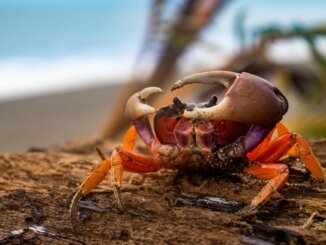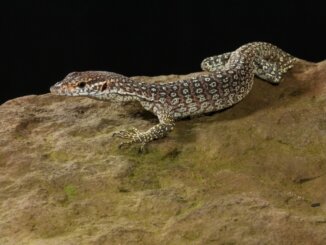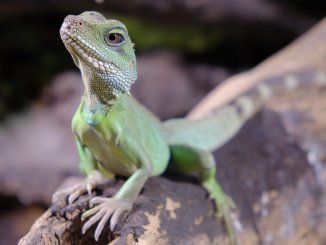The Chinese cave gecko has a black and gray body with bright orange, yellow, and white bands or patterns across its body. The nocturnal gecko is native to lowland rainforests in China, Japan, and Vietnam.
Chinese cave geckos are easy to care for because they’re hardy reptiles. However, these geckos require specific temperature and humidity requirements to keep them healthy and happy.
Chinese Cave Gecko Overview
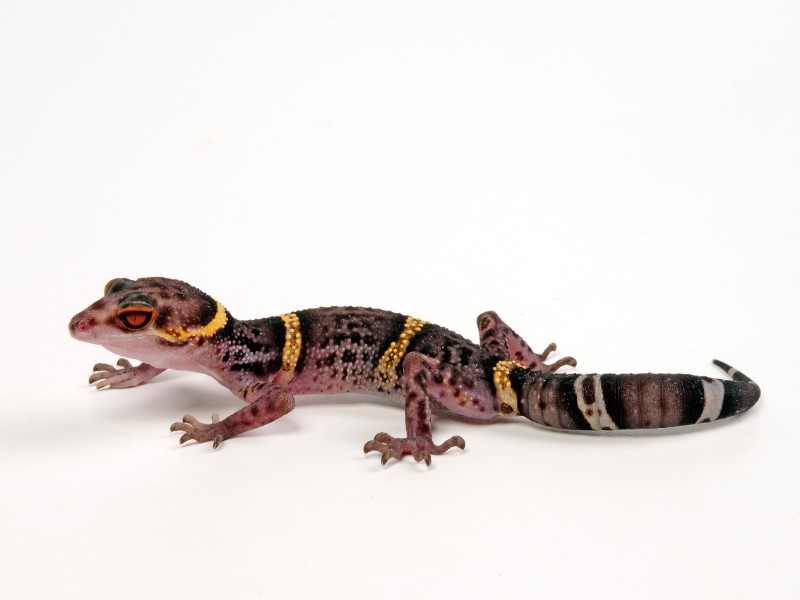
| Common names | Chinese cave gecko, Hainan cave gecko |
|---|---|
| Scientific name | Goniurosaurus hainanensis |
| Natural habitat | Rocky areas and caves in lowland rainforests native to Southern China, Japan, and Vietnam |
| Adult Size | 8–9 inches |
| Average Lifespan | Live insects like crickets, dubia roaches, and mealworms |
| Housing | A 30-gallon tank or 18 x 18 x 30-inch terrarium with a humidity level of 60%–80%, gradient temperature from 70–82°F with UV and UVB bulbs |
| Experience level | All experience levels |
Origin
The Chinese cave gecko (Goniurosaurus hainanensis) is found in Japan, Vietnam, and Southern China, specifically on the Cat Ba and Hainan islands. The gecko prefers rocky areas and caves in dense, lowland rainforests. These areas are perfect because they have plenty of places to hide and ideal humid temperatures.
The geckos are popular among reptile keepers and are easily captive-bred, but wild geckos are scarce in the legal pet trade because the species is illegally hunted.
Appearance and Behavior
The Chinese cave gecko is predominantly gray and black or purple with white-banded stripes on its tail and orange, gold, or yellow stripes on its bumpy-skinned body. The gecko has striking red eyes. Unlike other geckos, this species has eyelids and uses claws instead of sticky toe pads to climb.
The gecko’s tail will fall off if the gecko is attacked, injured, or scared. While the tail does grow back, it won’t be as colorful as the original.
The male can be distinguished by the large bulge at the base of its tail, which indicates its reproductive organs.
Size and Lifespan
Chinese cave geckos are small reptiles that average between 8 and 9 inches from the tip of the snout to the end of the tail at full maturity. At the time of hatching, the geckos are about 3 inches long.
The geckos are hardy, and generally live between 10 to 12 years, and sometimes up to 15 years, when kept healthy with a good diet and the correct enclosure temperature and humidity levels.
Temperament
Chinese cave geckos are docile, shy, and nocturnal, only coming out in the evening and nighttime to climb and explore the habitat. The geckos do well in community tanks with tank mates of the same species. Juveniles do better than adults in large groups.
Keep adult geckos alone, or together if one male is included. Keeping two or more males together will result in fights, in which the geckos will lose their tails.
The geckos will become stressed when woken up during daylight hours and when overhandled. While timid at first, the geckos rarely bite and will get used to occasional handling. Frequent handling isn’t recommended.
Housing Chinese Cave Geckos

Chinese cave geckos are found in densely vegetated rainforests that have high humidity and low-temperature levels.
Due to their nocturnal natures, heat can harm these lizards. Keep the housing parameters at optimal levels to keep the geckos healthy and happy.
Enclosure size
Keep a Chinese cave gecko in a tank of 30 gallons minimum, or in a terrarium that measures 18 x 18 x 30 inches. A larger enclosure is recommended to provide hiding spaces and enough room for the gecko to exercise. Add extra height to give the gecko space to climb.
Keep small groups of Chinese cave geckos in an enclosure that is double the minimum size for one gecko, to prevent aggression and territorial behaviors.
Lighting
Lighting is required in the gecko’s enclosure to regulate the lizard’s internal clock. Additional lighting isn’t necessary if the enclosure receives plenty of natural ambient light. However, extra lights can be added to control the temperature and daylight hours.
UV and UVB light is recommended to provide the reptile with vitamin D, improve digestion, and strengthen the reptile’s immune system. Place the UVB lamp in a vivarium electronics fixture on the basking side of the enclosure. Replace the bulb every 6 to 12 months based on the manufacturer’s recommendations.
Provide the gecko with 10½ hours of daylight during winter and 13½ hours of daylight during summer to mimic the seasonal lighting cycles.
Temperature and Humidity
The Chinese cave gecko needs cool temperatures in captivity that mimic its natural habitat. Use a gradient heating system to allow the gecko to walk around the enclosure and self-regulate its temperature.
The cooler side of the enclosure should remain between 70–75°F. The warmer side of the enclosure should stay between 80–82°F. Nighttime temperatures can drop to 68°F but should remain around 70°F.
Place two thermometers in the enclosure, or use a temperature gun, to constantly monitor the temperatures on both the cool and warm sides. Too much heat will harm the reptile.
Use a ceramic heat bulb, incandescent bulb, or a heating pad underneath the tank to provide the correct temperature. Take care when using heating pads because these can overheat the enclosure.
The correct humidity level is essential to keep a Chinese cave gecko healthy, especially during shedding season. The humidity should remain between 70%–80% at all times, without dropping below 60%.
Monitor the humidity levels in the enclosure using a hygrometer, and maintain the correct humidity by misting the plants. Misting can be done daily, as often as needed, or more often when the gecko is shedding. Keep a shallow water bowl in the enclosure as well to promote humidity. Keep the substrate partially dry or moist, but not soaking wet.
Keep the enclosure well-ventilated and humidity level in check to prevent fungus and bacteria growth.
Substrate and Decoration
A natural enclosure filled with a substrate that retains moisture is best for a Chinese cave gecko. Place at least 2 inches of cypress mulch, sphagnum moss, peat moss, or coco fiber in the enclosure. Add more substrate if live plants are added to the setup. Avoid substrates like gravel, cat litter, sand, and small bark chips because these could harm the gecko if ingested.
Decorate the enclosure to mimic the natural habitat, with places where the Chinese cave gecko can hide and with structures it can climb. Place driftwood, thick branches, climbing vines, large rocks, and cork bark to provide low basking and climbing spaces for the gecko, and add logs, tunnels, caves, and hide boxes for the gecko to sleep in.
Add a moist hide with extra sphagnum moss inside the enclosure to help the gecko shed.
Include live or nontoxic artificial plants in the enclosure for extra hiding spots. Make sure any plastic artificial plants will hold water because the geckos will lick water droplets off the leaves.
Cleaning
Clean a Chinese cave gecko’s enclosure regularly to prevent bacteria and fungus growth due to the humidity. Spot clean the enclosure daily and remove fecal matter, shedding remains, and dead insects. Stir the substrate to prevent mold growth. Clean the water and food dishes daily using warm soapy water or reptile-safe cleaner.
Clean the enclosure thoroughly every six to eight weeks by replacing all of the substrate and scrubbing the enclosure and decorations using reptile cleaner, a mixture of vinegar and water, or hot soapy water. Rinse the enclosure and decorations with hot water and let everything air dry completely.
Move the gecko to a small contained space during deep cleans. Put the gecko back in the enclosure only when the enclosure has dried completely and the new substrate has been added.
Chinese Cave Gecko Care
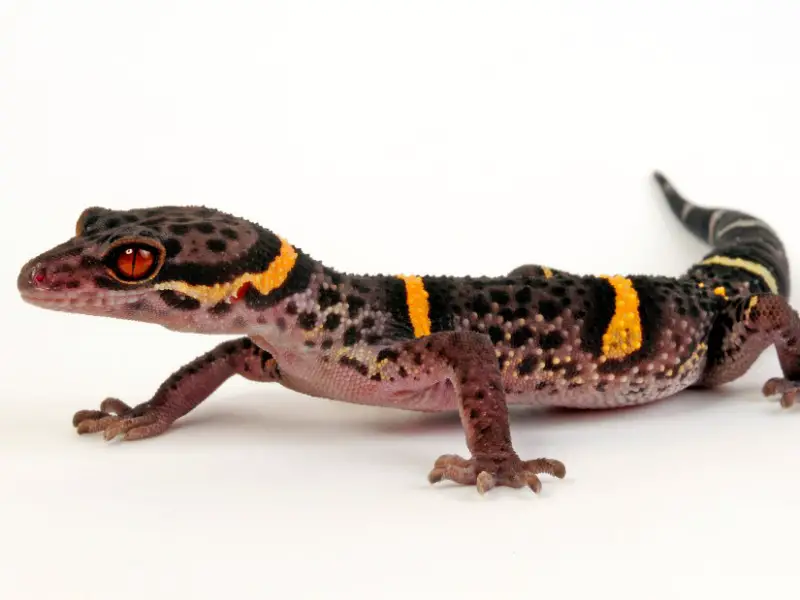
Chinese cave geckos are easy to care for because they only need a simple diet of insects, clean water, and the right humidity and temperature levels to remain healthy.
Food and Water
Feed Chinese cave geckos a diet of live, gut-loaded insects that are no larger than the space between the gecko’s eyes. Feed juveniles daily, and adults every other day. Feedings can consist of dubia roaches, butterworms, black soldier fly larvae, crickets, waxworms, and mealworms. Feed the gecko at night and only as much as it can eat within 15 minutes — about 8 to 10 insects for an adult.
Sprinkle calcium and vitamin D supplements onto food daily for juveniles and three or four times a week for adults. Add a multivitamin or mineral supplement dusting to the food once a week.
Keep a medium-sized, shallow water bowl in the enclosure at all times, and replace the water daily. A Chinese cave gecko will usually drink water droplets off its face or plants, but will sometimes drink from a dish.
The water should be shallow enough for the gecko to stand in without its head being submerged. These geckos can’t swim and might drown if the water is too deep.
Handling
Only handle the Chinese cave gecko when necessary. Handling can occur while cleaning the enclosure, and only in the evening or night when the gecko is naturally awake.
Handling the gecko as a juvenile for 15 minutes at a time will introduce the reptile to handling. Overhandling (more than once a week), or waking the gecko to pick it up, will cause unnecessary stress. Never handle the gecko while it’s shedding, as this can harm its skin. Don’t squeeze the gecko because it will likely drop its tail from stress.
Common Health Issues
Chinese cave geckos are hardy reptiles but have the potential to suffer health problems if they aren’t looked after correctly. Incorrect heat and humidity are the most common causes of health issues in these reptiles. These housing problems can lead to inflammation, respiratory issues, and fungal or bacterial infections.
Other common health conditions to look out for in this reptile include:
- Dysecdysis: Caused by improper shedding, evident by pieces of skin stuck to the body after shedding, usually around the eyes and toes. This condition is caused by a dry habitat or an underlying disease. Treat the condition by increasing the humidity in the enclosure and contacting a veterinarian if there is no improvement
- Gastrointestinal disease: Caused by a parasitic, viral, or bacterial infection, and the symptoms include weight loss, bloody or runny stools, and loss of appetite. Contact a veterinarian to diagnose and treat the problem
- Skin problems: Caused by incorrect humidity levels, bacterial, viral, or parasitic infections, or an unclean habitat. These problems are evident by swelling, redness, discoloration, or lesions on the skin. To treat these conditions, clean the habitat regularly, keep the heat and humidity at the correct levels, and consult a veterinarian if there is no improvement
Breeding
Chinese cave geckos breed readily in captivity without intervention as long as the heat and humidity are kept to optimal levels. In captivity, these geckos reproduce during the spring and summer months. Monitor the breeding season and intervene when the eggs are laid.
The female will lay two eggs per clutch every 30 to 45 days, with an average of four clutches per breeding season. To encourage breeding, place a male into the females’ enclosure in the early spring months. Pair one male with up to three females in a large enclosure and ensure there is enough food, water, and space in the tank.
- Look for a gravid female a few weeks after a male is introduced to the female enclosure. The gravid female will have a bulging belly and you may be able to vaguely see the eggs through the semi-translucent skin
- Leave the geckos alone, apart from feeding and maintaining the enclosure, during breeding to prevent stressing the reptiles. Gently look for eggs in the substrate every other day or wait until the female is noticeably slimmer
- Remove eggs from the enclosure once they’re laid, and externally incubate them in a well-ventilated container lined with a moist commercial hatching medium and with a temperature of 85°F. The geckos will hatch in 60 to 70 days
- Monitor the medium and add distilled water when it feels dry to the touch
- Transfer the hatched geckos immediately to a 10-gallon enclosure or a commercial hatchling enclosure equipped with a humidity chamber
- Use paper towels as the substrate, and monitor hatchlings’ health by watching food intake and fecal matter. Keep the humidity and temperature slightly higher than the adult enclosure
- Feed hatchlings daily with a diet of flightless fruit flies, pinhead crickets, and bean beetles
- Separate the males as soon as sexing is possible
The adult geckos may continue breeding throughout the year. The male and female need to be separated during the winter months to allow the geckos to rest and build their fat reserves.
Choosing and Buying a Chinese Cave Gecko
Chinese cave geckos cost between $100–$300. Buy the geckos from a reputable breeder to protect the limited number of wild geckos and to ensure a healthy pet.
Captive-bred geckos are healthier and less stressed than wild-caught geckos, making them a better option for a pet.
When buying a Chinese cave gecko, look for signs of good health such as clear and bright eyes, supple skin, firm droppings, and a clear nose and vent. Avoid geckos with signs of ill health such as lethargy, bloody or runny stool, and lesions or discolored skin.

